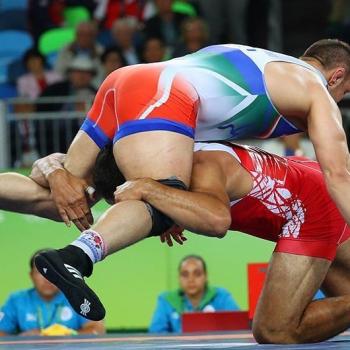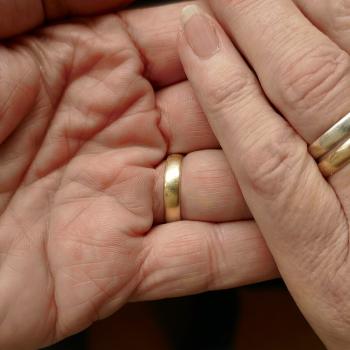My friend Emily DeArdo and I have a fitness club. It meets via text message, and it involves reporting in how we’re doing and how our day went, and congratulating each other for making good decisions where our health is concerned.
And here’s the thing: Emily is the girl who has kept me going on exercise, and not giving up, when it was extremely difficult to believe that it mattered.
When you have a chronic illness, exercising is really hard. There are lots of obstacles, situations where you just can’t, and you don’t get the amazing results that other people get. Last autumn I needed to hear from Emily: “Yes, my training at the gym is working. I am gaining strength and endurance.”
I needed to hear it because if Emily DeArdo can get improvements at the gym? You probably can too.
I held onto that all this fall when I was laid out flat with the latest exacerbation of my (much different) illness. I wanted to be working out, and I just couldn’t. The best I could do (see below) is identify a sustainable step count and aim for that (with just essentials of self-care and time with the family), and accept that it would take a lot of rest and strategizing even to function at the minimal sustainable level.
But it paid off! Eventually the exacerbation cleared up, and that discipline I’d developed let me hit the ground running (literally, within a few weeks, though it was mostly walking at first, see below about that, too) and get back on the training plan.
So today I want to talk about the reality of exercise when you have a chronic illness that significantly hampers your ability to exercise.

Updated: A word about ME before we continue . . .
I’m reminded on World ME Awareness Day that for the disorders in the myalgic encephalomyelitis / chronic fatigue syndrome constellation, including the form of post-COVID syndrome that falls into that grouping, post-exertional malaise is the extremely serious, defining pathology, and it directly inhibits your ability to increase your amount of exercise, because it is specifically a disorder of exercise-recovery.
So when I warn about “don’t wreck yourself” below? If you have ME/CFS, that warning is a flaming volcano and you need next-level caution, because the downside is much, much greater than average, even in sick-people world.
–> I would advise here that if you have a new-onset illness characterized primarily by fatigue, act as if it’s ME until you are certain it’s not. Don’t do the ramping up. Do the part where you dial back and rest enough. If it’s not ME/CFS, it’ll become clear with time. (And, you’re going to your doctor and running all the test to see if it’s something easy to diagnose or urgent to treat, right?)
And for everyone, seriously: You need to learn about the unique features of your disease and know what the specific hazards are that you have to caution against. What follows are some general concepts, but liver disease is different from heart disease is different from lung disease . . . and so on. Your have to add in your personal factors and adapt accordingly.
Now carrying on with the previously-published post . . .
Exercise matters.
Dr. Howard Luks is on my priority-follows list on Twitter, one of the handful of people I’ve picked to be my positive brain-break when I just want to chill and be inspired. (Emily’s there, so is John Herreid with all his great art posts . . . it’s a variety of interesting people who make my day better with what they say.)
I don’t know Dr. Luks and I haven’t read his book. What I know is that his blog and his tweets contain lots of good, important information about why exercise matters:
- Leg strength is important for health and longevity.
- Sarcopenia is the enemy: Muscle Mass, Strength and Longevity
- Physical fitness protects your brain, too: Delaying Alzheimer’s Disease and Neurocognitive Decline: Let’s Stay Active Longer
I need these reminders, so I keep a flow of them in my life. If you are not working hard to build and maintain muscle mass, mobility, and aerobic conditioning? You’re in trouble.
But if you have a serious chronic illness, you probably feel like all this is impossible. You’re not alone.
The fitness world doesn’t know what to do with sick people.
That includes doctors. Here’s Dr. Luks at a loss about people like us. At the end of the tweet I’m about to link, he writes:
And yes, I do realize there are many people who are ill, disabled, disadvantaged, and otherwise cannot exercise, afford fresh produce etc… but I still think it’s worth sharing this info with the rest of the population that this is worthy of consideration.
But what he writes is still true even if you have an illness that hampers your ability to exercise:
Our expected lifespans in the US are shortening. The incidence of frailty is increasing. The prevalence of heart disease and cancer in the US is increasing.
This isn't rocket science. We have a healthcare system that does a fabulous job if you need open heart surgery, a…
— Howard Luks MD (@hjluks) May 6, 2023
It is still true that exercise is beneficial and necessary even though most fitness writers are athletes, and most exercise scientists are focused on peak human performance.
It is still true even though the usual standards for what you “ought to be able to do” are absurdly out of reach for many people with chronic illness.
Fitter is still better, even when your “fitter” is barely on the fitness radar.
My favorite fitness bloggers and podcasters tend to be like “Okay, for this problem, what you need to do is these many pull-ups, and . . .” Um, okay. What if I have that problem, but I can’t do a pull-up?
Well you know what, sick people? There are other exercises you can do if you can’t do a pull-up. And you can do them fewer times, or with less resistance, or whatever it takes so that you are exercising the amount that you can.
That’s all you can do. But you will be healthier than you otherwise would be if you build that muscle mass, even if what you build is invisible to these fitness gurus.
So I’m here to tell you: Come join the club of sick people who reap the benefits of exercise, even if no one else in the world thinks it’s really happening.
And that’s the rest of this post: How to get yourself into the mental space where you can do that, and how to approach your training plan when you can’t just follow some recommended workout created for regular people.
Let’s start with the mental game.
You have to prioritize stewardship of your health.
This is really hard, because everybody around you wants stuff out of you. Even if you were a regular person, you could not give everybody that piece of you they’re trying to take.
When you are a sick person, you have to be much more intense about setting boundaries. Everyone’s going to be playing the game of “If she can do that, why can’t she _______?”
The answer is: She can’t do the lower priority item because she chose to do the more important thing.
So you have to get to a place where you recognize: Taking care of my body is more important than other stuff people want from me, because if I don’t take care of it right now as a high priority, I’m going to be even sicker or deader down the road, and then who are they gonna whine to?
It really sucks having to make these trade-offs.
It’s a lose-lose life you’re living. No matter what you prioritize, you will have to give up some extremely important things.
Regular people are like, “I prioritize things like family, friends, quiet moments savoring the sunset . . . you just have to focus on what really matters in life.”
Sick people are like: “Yeah, I have to choose whether to talk to my kid for five minutes today or brush my teeth. Maybe I can do two minutes with the kid and some mouthwash.”
Even if you’re not that sick right now? You have to get very far into regular-people territory for a long time before you’re going to be able to do all the basic things that matter most.
Until then, you’re going to constantly be having to thicken your skin and accept that the life you actually have is one where you have to say no to things — people, mostly — that you truly treasure.
This is why it is so hard to exercise enough when you have a chronic illness.
It takes ruthless determination to not make that phone call to someone you love so that you can go to the gym instead. But you, unfortunately, have to choose. And if you don’t choose the gym today, there will be no phone call tomorrow.
We’re not talking about you putting your Olympic dreams above close family and friends. We are talking about the fact that if you don’t get very, very serious about your physical training you will be dead sooner. And then the people who joke about how you’re so hard to get on the phone will really know what “hard to reach” is like.
When you can, train as hard as you can reasonably, safely sustain.
Different illnesses take on different contours. My friend Emily, a double-lung transplant recipient with cystic fibrosis, has a fairly stable situation overall, punctuated by bouts with infections or other setbacks that require rest and recovery.
In contrast, I have a relapsing-and-remitting illness. When I am seriously sick, Emily’s normal runs circles around me. But when I’m not in a sick phase, I can do way more than she can. Your situation is probably yet different from either of us.
Regardless, there are likely times when you can do relatively more, and times when you really can’t.
During those times when can do more, physically, there are going to be many, many things you are going to want to catch up on. During those times, though, you need to be banking physical fitness.
Fitness-banking is a thing.
You need as much muscle mass as you can get. You need as much aerobic conditioning as you can get. You need as much strength, balance, and mobility as you can get.
When you are more-sick, some deconditioning is going to occur. You can’t help that or change that.
What you can control is your starting point. If you lose 10% of your muscle mass while you’re down with a bad bout of the thing, yeah that sucks — but it sucks way more if you didn’t have much to begin with. Which means that when you can*, you need to hyper-focus on strength training, even though it means missing out on other stuff.
*You can’t always.
Everyone dies in the end.
It is really discouraging when you have to put so much work and discipline and self-denial into fitness training, and you still look and feel like a lump. It’s not fair that other people get to keep their fitness gains, because they don’t have bouts of some stupid illness. It’s not fair that other people can train more intensely with bigger results and far less sacrifice, because they have normal bodies that can do that.
Well, okay. You know what else is not fair? You cheating yourself out of being as healthy as you can be.
Exercise is always, for everybody, a temporary game. No one escapes death forever. No one stays perfectly healthy forever, no matter how amazing their health-and-wellness game. But guys, everyone gets the same amount of eternity.
What you’re deciding with how you exercise isn’t whether you will one day be sicker and later be deader. What you are deciding is: Will I be as healthy right now as I can be? And will I be as healthy as I can be for as long as I can be?
Exercising isn’t selfish.
This is a huge mental shift you have to make.
You think, “Oh I’m so humble with putting others first, and not being vain about my appearance, and being so accepting of my difficult lot in life.” Okay that’s fine as far as it goes.
But also, if you don’t do what you reasonably can to take care of the body that has been given to you — even if it’s a bit of a clunker — then you are being selfish. You are making the decision to have less time and less ability to be with others and to serve others.
The point of serious fitness training for sick people isn’t that we’re going to impress anyone. We aren’t. Sorry. The point is to be there for others as well as you can. And fitness makes a huge difference in the course of your disease (yes, it does!).
There are no guarantees, of course. If you knew exactly when and how you would die, you could carefully steward all but the last ten days, and then binge on Krispy Kreme with your besties and go out in style.
That is not reality. Reality is that you need to invest in your physical health as if you aren’t going to get hit by a bus tomorrow morning. Your responsibility isn’t to control what you can’t control and can’t know. Your responsibility is to consider the fact that you might not get hit by a bus tomorrow, and prepare for that.
Okay, so what does that look like?
Let’s start with reality when you’re super sick and honestly you can’t do much at all.
When you can only do very, very little, prioritize:
Non-negotiable medical care. Let’s be real: Little things like taking your medicine you’ll get seriously sick (or sicker) without, checking your blood sugar if you have diabetes, monitoring your blood pressure if you have hypertension . . . these require physical energy. Depending on your health condition, you probably have some true do-or-die interventions. Do those.
Put lower on the list things that might-be-nice but honestly aren’t personally major risk factors for you.
True do-or-die chores. Maybe the garbage really has to go out today, because otherwise you have a serious sanitary situation on your hands. Okay, take it out. Or maybe you can tie up that bag and set it aside and someone else can take it out later, and that’s not your first choice but it’s FINE.
Your energy goes first to the things that really, truly must be done. If it can wait, it gets downvoted on the priority list.
Rehabbing your biggest vulnerabilities. Those exercises that help your bad knee, or balance training because honestly you need it, or stretches to keep the back pain down to a minimum . . . whatever it is. You know what your things are. If you can only do twenty-five seconds of exercise today, do the exercise that will shore up, even just a tiny bit, the thing that otherwise is gonna wreck you.
Prioritize this over low-urgency chores. You’re gonna have a lot harder time getting laundry done if you let your back go out again.
Sticking to a sustainable daily level of exertion. Maybe “sustainable” is:
- “I am going to eat today and also go to the toilet and frankly if I do those two we’re calling it a victory.”
- Or: “I can do up to 2,000 steps a day, and if I obsessively stay under that ceiling, I can reliably do it again tomorrow and the day after.”
- Or: “I will do the top thing on my list (um, those meds?), and then rest. When I feel energetic again, I will do my #2 priority (food? toilet?).” And you slowly turtle your way through the day, and it works for you.
And that’s it. Stick to sustainable.
The thing you are missing is that regular people are not living at their maximum capacity.
Even professional athletes aren’t pushing themselves so hard that they literally, really truly could not brush their teeth at the end of the day if they added one more thing. They just go run the Ironman and then they’re like, “Yeah I can also brush my teeth today I have so much extra energy even after doing that.”
Sick people are on a different plan. Your daily sustainable energy output is intensive training. The discipline of sticking to what you can sustain will pay back so, so much.
Err on the Side of Being a Little Too Careful
So you think you can probably do 2000 steps a day? Yeah let’s see 1500 for a week and then we’ll talk.
Exercise guide suggests starting with five pound weights? We’re starting with zero weights, and if that works we’ll up it to a pound. Three sets of ten? Nope, one set of three. 90 degree angle on that new stretch? Okay well we’re starting with 45 and we will see from there.
See, the thing is: You can always add more. You cannot undo an injury.
If you wreck yourself, it is going to cost you much, much more than it will cost a regular person.
When everything goes fine with your initial, super-cautious approach? Great. Increase the intensity a tiny bit and see how it goes. If it’s still fine, sure, inch it up another notch.
If you do this, eventually you will safely get to your sustainable max. Sure, it is slower progress than if you had somehow magically known exactly what you could do before you even tried. But this isn’t fairyland, and also you know what slows down your progress? Getting injured.
Intensify when you can, and don’t dilly dally about it.
When you are feeling relatively better, here is what you are going to want to do:
- Get out and tackle that huge, physically intense project that really needs to be done, even though you are deconditioned from being so sick and it’s probably going to wreck you.
- Tackle a million little things that you are so behind on that if you did nothing but chores for the next six years, maybe you could catch up.
- Spend time with people and get back to all your old activities.
- Eat donuts. Hurray, you’re better!
Here is what you have to do instead:
- Slowly, carefully, ramp back up your conditioning program, and wait on physically intense chores until you have built back up the strength to do them safely.
- Work through only the highest priority backlog of chores first. Yes, you need to get the IRS off your back. Immediately. No, you don’t have to clean out right now that closet that frankly someone else can deal with if it comes to it, it’ll keep until later.
- Continue thinking carefully about your priorities. Who are the people who truly have a claim on you above all others? What are the activities that contribute most to your mental health, even if they seem gratuitous or “wasteful” to other people who are not you?
- Slowly but seriously ramp back up on your conditioning program.
–> I’ll note, however, that chores are exercise. They just aren’t always the right kinds of exercise in the right proportions. The key is they need to be the exercise that fits into your conditioning plan. Don’t sort the odd sock basket instead of completing the strength training workout you would otherwise be ready to do. But if your fitness plan legit calls for a short, light walk, it’s okay if your house is cleaner at the end of that walk.
And then here is what you need to do next, if you keep being pretty healthy overall, for you:
- Continue slowly but seriously ramping up on the conditioning program, even if you are back to where you were before.
Even if you get to where you’re in pretty good shape for someone your age? Even if you are fitter than you’ve ever been? Keep going.
You are not a regular person. You have to bank your fitness while you can, and bank as much as you can, because when you get sicker again, you are going to need that reserve.
Keep exploring until you find the kind of exercise that works with the body you have today.
What I do for exercise is constantly changing because my body is constantly changing.
I love the outdoors. I like yardwork, hiking, camping, biking . . . all kinds of outside activities. Also, I live in the Deep South. Before I developed an illness that is made worse by heat exposure? I was the queen of heat adaptation. A little insufferable about it, ask anyone.
I was good at exercising in the heat. I was dying laughing back during the Atlanta Olympics when there were all these articles about athletes having to deal with heat and humidity, oh my. Poor babies.
Well, that was before. And I do still work the heat-adapting as much as I can? But also I finally realized I needed to find options for exercise during the hot-season that were compatible with the body I have today.
Maybe one day, because I do keep working on the heat-adapting within my capacity for that, I’ll be able to get more summer outside-time. For now, ice skating it is. You could do a lot worse.
You have to become the expert in adapting recommendations.
The other day Emily was talking about the value of wall sits, and I balked. They don’t go well for me. And somewhere in that conversation came the aha-moment: I don’t have to go into a deep wall sit. There is still strength-training happening even if I’m sitting at a much shallower angle.
The thing is: Only I can know what that angle is.
A physical therapist can’t feel my knee creaking, even if she’s watching carefully for all the right body mechanics. A fitness guru on the internet can’t write up a special version of his go-to workout Just for Jennifer. A doctor making general recommendations about “getting more exercise” is not living my daily life.
So I have to be the leader. I have to be the one who pays careful attention to my body and makes smart decisions about what I can and can’t do.
And the same goes for you. Become the leader in making the final judgement call on what you can do and how much you can do.
When you do that, exercise becomes good.


















